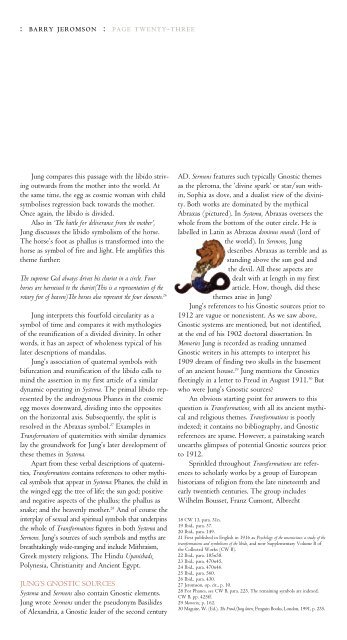a semi-annual publication of the philem n foundation - Philemon ...
a semi-annual publication of the philem n foundation - Philemon ...
a semi-annual publication of the philem n foundation - Philemon ...
Create successful ePaper yourself
Turn your PDF publications into a flip-book with our unique Google optimized e-Paper software.
: barry jeromson : page twenty-three<br />
Jung compares this passage with <strong>the</strong> libido striving<br />
outwards from <strong>the</strong> mo<strong>the</strong>r into <strong>the</strong> world. At<br />
<strong>the</strong> same time, <strong>the</strong> egg as cosmic woman with child<br />
symbolises regression back towards <strong>the</strong> mo<strong>the</strong>r.<br />
Once again, <strong>the</strong> libido is divided.<br />
Also in ‘The battle for deliverance from <strong>the</strong> mo<strong>the</strong>r’,<br />
Jung discusses <strong>the</strong> libido symbolism <strong>of</strong> <strong>the</strong> horse.<br />
The horse’s foot as phallus is transformed into <strong>the</strong><br />
horse as symbol <strong>of</strong> fire and light. He amplifies this<br />
<strong>the</strong>me fur<strong>the</strong>r:<br />
The supreme God always drives his chariot in a circle. Four<br />
horses are harnessed to <strong>the</strong> chariot(This is a representation <strong>of</strong> <strong>the</strong><br />
rotary fire <strong>of</strong> heaven)The horses also represent <strong>the</strong> four elements. 26<br />
Jung interprets this fourfold circularity as a<br />
symbol <strong>of</strong> time and compares it with mythologies<br />
<strong>of</strong> <strong>the</strong> reunification <strong>of</strong> a divided divinity. In o<strong>the</strong>r<br />
words, it has an aspect <strong>of</strong> wholeness typical <strong>of</strong> his<br />
later descriptions <strong>of</strong> mandalas.<br />
Jung’s association <strong>of</strong> quaternal symbols with<br />
bifurcation and reunification <strong>of</strong> <strong>the</strong> libido calls to<br />
mind <strong>the</strong> assertion in my first article <strong>of</strong> a similar<br />
dynamic operating in Systema. The primal libido represented<br />
by <strong>the</strong> androgynous Phanes in <strong>the</strong> cosmic<br />
egg moves downward, dividing into <strong>the</strong> opposites<br />
on <strong>the</strong> horizontal axis. Subsequently, <strong>the</strong> split is<br />
resolved in <strong>the</strong> Abraxas symbol. 27 Examples in<br />
Transformations <strong>of</strong> quaternities with similar dynamics<br />
lay <strong>the</strong> groundwork for Jung’s later development <strong>of</strong><br />
<strong>the</strong>se <strong>the</strong>mes in Systema.<br />
Apart from <strong>the</strong>se verbal descriptions <strong>of</strong> quaternities,<br />
Transformations contains references to o<strong>the</strong>r mythical<br />
symbols that appear in Systema: Phanes, <strong>the</strong> child in<br />
<strong>the</strong> winged egg; <strong>the</strong> tree <strong>of</strong> life; <strong>the</strong> sun god; positive<br />
and negative aspects <strong>of</strong> <strong>the</strong> phallus; <strong>the</strong> phallus as<br />
snake; and <strong>the</strong> heavenly mo<strong>the</strong>r. 28 And <strong>of</strong> course <strong>the</strong><br />
interplay <strong>of</strong> sexual and spiritual symbols that underpins<br />
<strong>the</strong> whole <strong>of</strong> Transformations figures in both Systema and<br />
Sermons. Jung’s sources <strong>of</strong> such symbols and myths are<br />
breathtakingly wide-ranging and include Mithraism,<br />
Greek mystery religions, The Hindu Upanishads,<br />
Polynesia, Christianity and Ancient Egypt.<br />
JUNG’S GNOSTIC SOURCES<br />
Systema and Sermons also contain Gnostic elements.<br />
Jung wrote Sermons under <strong>the</strong> pseudonym Basilides<br />
<strong>of</strong> Alexandria, a Gnostic leader <strong>of</strong> <strong>the</strong> second century<br />
AD. Sermons features such typically Gnostic <strong>the</strong>mes<br />
as <strong>the</strong> pleroma, <strong>the</strong> ‘divine spark’ or star/sun within,<br />
Sophia as dove, and a dualist view <strong>of</strong> <strong>the</strong> divinity.<br />
Both works are dominated by <strong>the</strong> mythical<br />
Abraxas (pictured). In Systema, Abraxas oversees <strong>the</strong><br />
whole from <strong>the</strong> bottom <strong>of</strong> <strong>the</strong> outer circle. He is<br />
labelled in Latin as Abraxas dominus mundi (lord <strong>of</strong><br />
<strong>the</strong> world). In Sermons, Jung<br />
describes Abraxas as terrible and as<br />
standing above <strong>the</strong> sun god and<br />
<strong>the</strong> devil. All <strong>the</strong>se aspects are<br />
dealt with at length in my first<br />
article. How, though, did <strong>the</strong>se<br />
<strong>the</strong>mes arise in Jung?<br />
Jung’s references to his Gnostic sources prior to<br />
1912 are vague or nonexistent. As we saw above,<br />
Gnostic systems are mentioned, but not identified,<br />
at <strong>the</strong> end <strong>of</strong> his 1902 doctoral dissertation. In<br />
Memories Jung is recorded as reading unnamed<br />
Gnostic writers in his attempts to interpret his<br />
1909 dream <strong>of</strong> finding two skulls in <strong>the</strong> basement<br />
<strong>of</strong> an ancient house. 29 Jung mentions <strong>the</strong> Gnostics<br />
fleetingly in a letter to Freud in August 1911. 30 But<br />
who were Jung’s Gnostic sources?<br />
An obvious starting point for answers to this<br />
question is Transformations, with all its ancient mythical<br />
and religious <strong>the</strong>mes. Transformations is poorly<br />
indexed; it contains no bibliography, and Gnostic<br />
references are sparse. However, a painstaking search<br />
unearths glimpses <strong>of</strong> potential Gnostic sources prior<br />
to 1912.<br />
Sprinkled throughout Transformations are references<br />
to scholarly works by a group <strong>of</strong> European<br />
historians <strong>of</strong> religion from <strong>the</strong> late nineteenth and<br />
early twentieth centuries. The group includes<br />
Wilhelm Bousset, Franz Cumont, Albrecht<br />
18 CW 13, para. 31n.<br />
19 Ibid., para. 37.<br />
20 Ibid., para. 149.<br />
21 First published in English in 1916 as Psychology <strong>of</strong> <strong>the</strong> unconscious: a study <strong>of</strong> <strong>the</strong><br />
transformations and symbolisms <strong>of</strong> <strong>the</strong> libido, and now Supplementary Volume B <strong>of</strong><br />
<strong>the</strong> Collected Works (CW B).<br />
22 Ibid., para. 185n58.<br />
23 Ibid., para. 470n45.<br />
24 Ibid., para. 470n46.<br />
25 Ibid., para. 560.<br />
26 Ibid., para. 430.<br />
27 Jeromson, op. cit., p. 10.<br />
28 For Phanes, see CW B, para. 223. The remaining symbols are indexed,<br />
CW B, pp. 425ff.<br />
29 Memories, p. 162.<br />
30 Maguire, W. (Ed.), The Freud/Jung letters, Penguin Books, London, 1991, p. 235.


